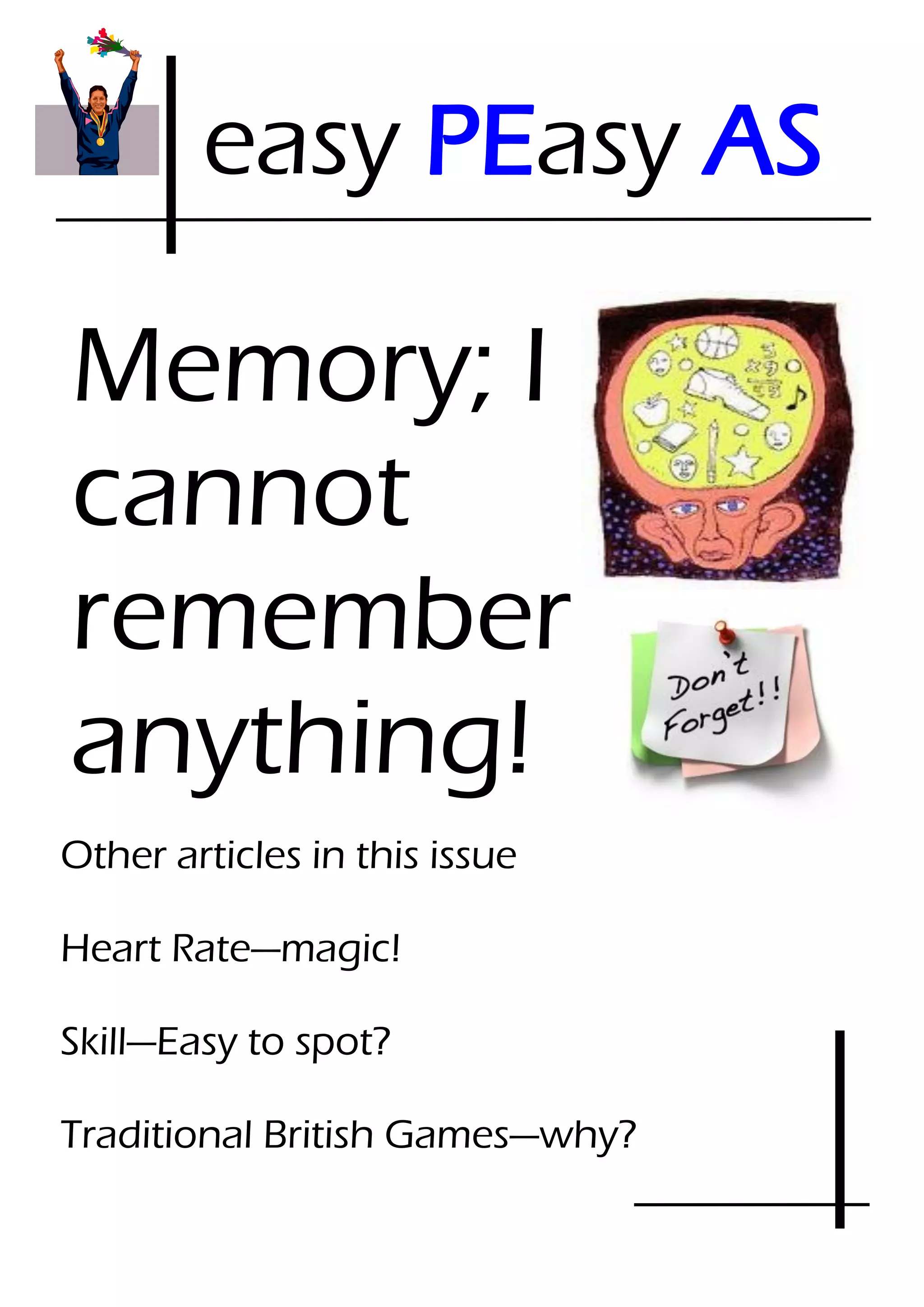This document provides information on various topics related to physical education and sport science. It includes short summaries and explanations of heart rate, memory, exam technique, joints, numbers, skill, traditional British games, reaction time, and Newton's laws. It also poses sample exam questions related to anatomy, skill, and socio-cultural topics. Overall, the document serves as a study guide for students by covering essential course content and concepts across multiple subject areas in a concise yet informative manner.





![Memory
Apparently they never forget..........but how
do we remember things and retrieve them for
use in the future?
Well there it is, hope you remember it. Article finished......lots of white space though. We bet-
ter explore this in detail to fill up the page!
Short Term Sensory Store.
Receives all the information from the display [environment]
Information lasts for less than a second
Unimportant information is lost
Selective Attention
Filters the relevant information for passing onto the short term memory
Disregards irrelevant information
Prevents overload of the information processing system.
Short Term Memory
STM holds 7(+-2) = 5-9 pieces of information
Lasts up to 30 seconds.
Chunks information together
Encodes information to LTM (on diagram at the top of this page)](https://image.slidesharecdn.com/easypeasyv1-2as-130213062803-phpapp02/75/easy-PEasy-Issue-1-6-2048.jpg)


![Is it easy to spot skilful
performances?
How can we compare Pele to Phil Taylor?, Shane Warne to Maria Sharapova? Michael
Schumacher to Frankie Dettori? Paula Radcliffe to Tiger Woods?
―The behaviour which tends to eliminate the discrepancy between intention and perform-
ance‖ (Oldfield)
―The learned ability to bring about pre-determined results with maximum certainty often with
the limited outlay of time, energy or both‖ (Knapp)
―An act or task that has a goal to achieve and that requires voluntary body or limb movements
to be properly performed‖
(Magill)
I think we‘d all agree that in their given fields, they are at the top of their game and therefore
extremely skilful. Many others could be thought of and compared against. Do these perform-
ers fit the quotes above about skilful performance? From these quotes we can see how they
all in some way shape or form fit the given characteristics of skill. All of these performances
can be related to certain characteristics that represent skilful performances. These characteris-
tics can be applied to all skilful performances in one way or another.
Characteristics of Skill…………
Learned - Player is taught a tennis serve and practices it
Aesthetic - The gymnasts floor routine is pleasing to the eye
Co-ordinated - The basketball lay up is not jerky
Efficient - The swimmer moves effortlessly through the water
Fluent - The movement flow into each other—eg Triple jump
Technical Model - Follows a technical model, a batsman playing a text book
Cover drive
Goal Directed - The performer understands the requirements of the task
Golfer knows how and when to fade the ball
Do the above mentioned sports people fit into these characteristics? In their field of speciality
then the answer surely as to be yes?
There are also the added complication of different types of skill!!!!
Motor (voluntary with end result)
Fundamental (young skills that are learnt)
Perceptual (interpreting information)
Cognitive (problem solving)
Individual (no interaction with others)
Coactive (interaction with others)
Interactive (with the environment)
In order for these skilful characteristics to be developed and demonstrated then other parts of
the skill acquisition syllabus need to be addressed.
In order for skill to be achieved, ability must come into question? Many commentators suggest
that performers have great natural ability. Is that true? Abilities actually underpin skill!!!
Abilities are; genetic [from parents], stable [we don't lose our abilities].](https://image.slidesharecdn.com/easypeasyv1-2as-130213062803-phpapp02/75/easy-PEasy-Issue-1-9-2048.jpg)




